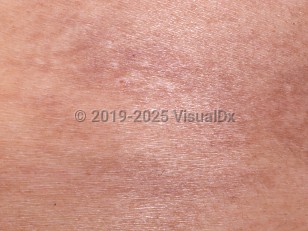Porphyrias are a group of diseases resulting from defects / dysfunction in enzymes involved in heme biosynthesis. Several porphyrias have cutaneous features. Porphyrias with blistering cutaneous features include porphyria cutanea tarda (PCT) and hepatoerythropoietic porphyria. Porphyrias with nonblistering cutaneous features include erythropoietic protoporphyria and X-linked protoporphyria. Porphyrias that can have both blistering cutaneous features and acute neurovisceral attacks include hereditary coproporphyria (HCP) and variegate porphyria (VP). Porphyrias with only neurovisceral symptoms without skin findings include acute intermittent porphyria and delta-aminolevulinic acid (ALA) dehydratase deficiency porphyria.
HCP is an extremely rare autosomal dominant disorder with incomplete penetrance, caused by deficiency of coproporphyrinogen oxidase (CPOX), an enzyme in the heme pathway.
HCP typically presents after puberty, but pediatric cases have been reported. It is more common in women.
HCP can have both cutaneous and neurovisceral symptoms. Neurovisceral attacks are potentially fatal. The spectrum of presentation is broad. Cutaneous manifestations are seen in 20%-30% of the patients with HCP and are similar to other blistering porphyrias (eg, PCT, hepatoerythropoietic porphyria, and VP), while the neurovisceral attacks are similar to other acute porphyrias (acute intermittent porphyria, ALA dehydratase deficiency porphyria, and VP).
Acute neurovisceral attacks are highly variable from patient to patient and can be characterized by fever, severe pain (eg, chest, abdomen, back, limbs), and gastrointestinal symptoms such as cramping, nausea / vomiting, constipation / abdominal distention, and rarely diarrhea. Cardiovascular effects can be seen with hypertension, tachycardia, and chest pain. Patients can experience psychological symptoms with anxiety, disorientation, agitation, and psychosis. Neurological symptoms include sensory and motor deficits and seizures; motor weakness can lead to respiratory failure, which can be fatal. Urinary retention can result from bladder paresis. Hyponatremia may result from nausea / vomiting and diarrhea or syndrome of inappropriate antidiuretic hormone (SIADH). Respiratory paralysis and cardiac arrhythmia can occur during acute neurovisceral attacks and signal a medical emergency.
Cutaneous findings are similar to other blistering porphyrias with photosensitivity, blisters, dyspigmentation, and scarring on sun-exposed sites (ie, face, neck, dorsal forearms / hands, and feet).
Risk factors for flares include certain drugs, metabolic stress (ie, low carbohydrate intake or sudden drop in weight), smoking, and alcohol use. HCP can flare with the luteal phase of the menstrual cycle.
There is an increased risk of hepatocellular carcinoma in patients with HCP, with ages of diagnosis ranging from 37-65 years of age; thus, routine monitoring is needed, particularly for those with other risk factors including cirrhosis, hepatitis C, or alcohol use disorder.
Emergency: requires immediate attention
Hereditary coproporphyria
Alerts and Notices
Important News & Links
Synopsis

Codes
ICD10CM:
E80.29 – Other porphyria
SNOMEDCT:
7425008 – Hereditary Coproporphyria
E80.29 – Other porphyria
SNOMEDCT:
7425008 – Hereditary Coproporphyria
Look For
Subscription Required
Diagnostic Pearls
Subscription Required
Differential Diagnosis & Pitfalls

To perform a comparison, select diagnoses from the classic differential
Subscription Required
Best Tests
Subscription Required
Management Pearls
Subscription Required
Therapy
Subscription Required
References
Subscription Required
Last Reviewed:02/26/2020
Last Updated:01/17/2022
Last Updated:01/17/2022
Emergency: requires immediate attention
Hereditary coproporphyria

